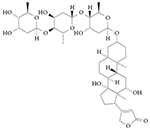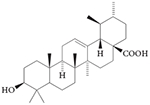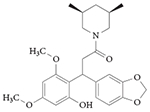| T0901317 |

|
RORα and RORγ inverse agonist RORα IC50 = 2.0 μM (measured by Gal4–UAS luciferase assay) RORγ IC50 = 1.7 μM (measured by Gal4–UAS luciferase assay) RORα Kd = 132 nM (measured by radioligand displacement) RORα Kd = 51 nM (measured by radioligand displacement) Does not bind to RORβ Also acts as LXRα and LXRβ agonist, FXR agonist and PXR agonist Increases the interaction between RORα and peptide fragment of the RIP140 co-repressor Suppresses G6PC and IL17 promoter activity Suppresses G6PC gene expression and decreases recruitment of SRC2 co-activator to the G6PC promoter
|
115
|
| SR1078 |

|
RORα and RORγ agonist Decreases interaction between RORγ and the peptide fragment of TRAP220 co-activator Suppresses transcriptional activity of RORα and RORγ in assays that use Gal4-chimeric receptors, but increases transcriptional activity of RORα and RORγ in assays that use full-length receptors Increases the expression of RORα and RORγ target genes in vitro and in vivo Has sufficient in vivo exposure for use as a chemical tool No activity at other nuclear receptors as defined in a Gal4-chimeric receptor assay
|
119
|
SR3335 (also known
as SR3335/ML176) |

|
RORα inverse agonist Ki = 220 nM (measured by radioligand binding assay) IC50 = 480 nM (measured by Gal4–UAS luciferase assay) Does not exhibit significant activity at other nuclear receptors (measured by Gal4–UAS luciferase specificity panel) Suppresses G6PC and PCK promoter activity Suitable in vivo exposure for proof-of-principle experiments Lowers plasma glucose levels in mouse model of diet-induced obesity Suppresses PCK expression in vivo No activity at other nuclear receptors as defined in a Gal4-chimeric receptor assay
|
125
|
| SR1001 |

|
RORα and RORγ inverse agonist RORα Ki = 172 nM (measured by radioligand binding assay) RORγ Ki = 111 nM (measured by radioligand binding assay) Inhibits RORγ activity on the IL17 promoter in a concentration-dependent manner RORγ IC50 = 117 nM (recruitment of TRAP220 peptide to RORγ LBD) Suppresses expression of IL17A and G6PC in cell culture Inhibits NCOR recruitment while promoting the recruitment of RORα and RORγ to the IL17A promoter in cells Affects the structural conformation of RORγ LBD and decreases interaction of SRC2 with RORγ Inhibits expression of IL17A, IL17F, IL21 and IL22 in cells Inhibits TH17 cell differentiation without affecting other TH cell lineages Inhibits secretion of IL-17 from CD4+ T cells Suppresses experimental autoimmune encephalomyelitis No activity at other nuclear receptors in a Gal4-chimeric receptor assay
|
125
|
| SR2211 |

|
RORγ inverse agonist Ki = 105 nM (measured by radioligand binding assay) IC50 = 320 nM (measured by Gal4–UAS luciferase assay) Weak activity on LXRα; no activity on FXR Affects the structural conformation of RORγ LBD Suppresses five copies of ROR response element and IL17 promoter in a luciferase assay in a concentration-dependent manner Suppresses IL17 expression and IL-17 production Suppresses TH17 cell differentiation No activity at other nuclear receptors in a Gal4-chimeric receptor assay
|
129,
130,
143
|
| SR1555 |

|
RORγ inverse agonist No activity at LXR, FXR and RORα IC50 = 1.5 μM Ki = 1 μM (measured in a radioligand binding assay) Suppresses IL17 promoter driven luciferase activity Suppresses IL17A, IL21 and IL22 expression in cells Increases FOXP3 expression in cells Inhibits IL-17 protein expression Inhibits TH17 cell differentiation Increases the frequency of TReg cells No activity at other nuclear receptor in a Gal4-chimeric receptor assay
|
130
|
| Digoxin |

|
RORγ inverse agonist IC50 = 1.98 μM (measured in a Gal4–UAS luciferase assay) IC50 = 4.1 μM (fluorescence polarization displacement assay) Suppresses IL-17A protein expression Suppresses IL23R, IL17A, IL17F and IL22 Inhibits TH17 cell differentiation without affecting the differentiation of other T cell lineages Suppresses experimental autoimmune encephalomyelitis Binds to the RORγt LBD
|
131,
132
|
| Ursolic acid |

|
RORγ inverse agonist IC50 = 680 nM (binding of SRC1 peptide to RORγt LBD) IC50 = 560 nM (TH17 cell differentiation assay) Suppresses RORγt activity on an IL17 promoter-driven luciferase reporter Suppresses IL17 expression Inhibits IL-17 protein production Inhibits TH17 cell differentiation Suppresses experimental autoimmune encephalomyelitis Has reported activity at the glucocorticoid receptor and non-nuclear receptor targets
|
135
|
| ML209 |

|
RORγ inverse agonist IC50 = 500 nM (measured in a Gal4–UAS luciferase assay) IC50 = 110 nM (measured in a fluorescence polarization displacement assay) Minimal activity on oestrogen-related receptor-α (IC50 = 4.5 μM), LXRα (IC50 = 10 μM), thyroid hormone receptor-α (IC50 = 4.5 μM), and thyroid hormone receptor-β (IC50 = 13 μM, in a Gal4–UAS luciferase assay) Suppresses IL17A expression Inhibits TH17 cell differentiation Specificity not published
|
144
|
| Compound 1a |

|
|
145
|
Compound 1b:
N-(4,6-dimethyl-
benzo[d]thia-
zol-2-yl)-3-methyl-
thiophene-2-
carboxamide |

|
RORγ agonist EC50 = ~100 nM (measured in an IL17 reporter assay) Shift of 2.26 °C circular dichroism thermal shift assay Augments IL-17 production in a dose-dependent manner (maximum effect was 220% at 3 μM)
|
145
|
Compound 1c:
N-(2-(4-ethyl-
phenyl)-2H-benzo-
[d][1,2,3]triazol-5-yl)
propionamide |

|
|
145
|
Inhibitor Y:
N-(5-benzoyl-4-p
henylthiazol-2-yl)-
2-(4-(ethylsulfonyl)
phenyl)acetamide |

|
Possibly a RORγ inverse agonist Inhibits the actions of compounds 1a, 1b and 1c in a concentration-dependent manner
|
145
|












